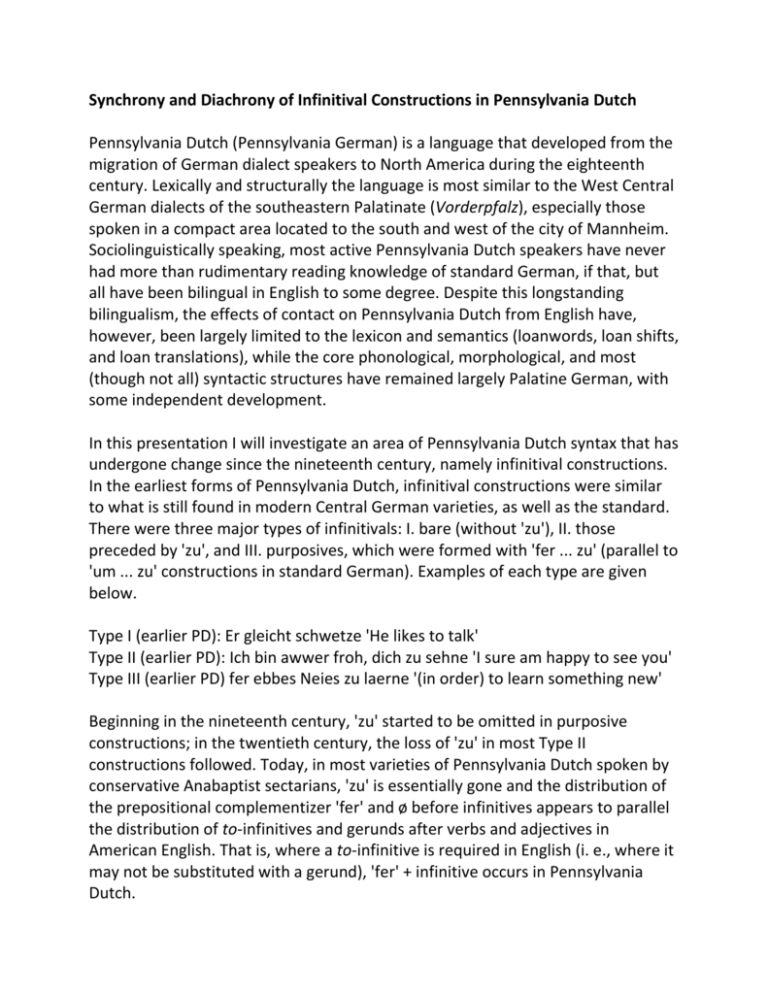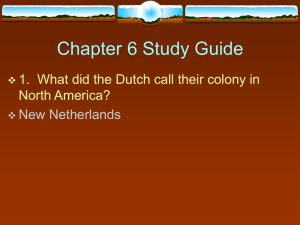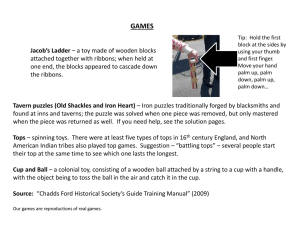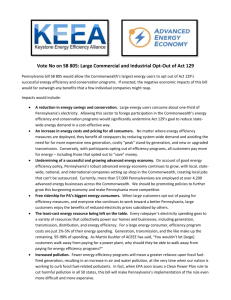abstract
advertisement

Synchrony and Diachrony of Infinitival Constructions in Pennsylvania Dutch Pennsylvania Dutch (Pennsylvania German) is a language that developed from the migration of German dialect speakers to North America during the eighteenth century. Lexically and structurally the language is most similar to the West Central German dialects of the southeastern Palatinate (Vorderpfalz), especially those spoken in a compact area located to the south and west of the city of Mannheim. Sociolinguistically speaking, most active Pennsylvania Dutch speakers have never had more than rudimentary reading knowledge of standard German, if that, but all have been bilingual in English to some degree. Despite this longstanding bilingualism, the effects of contact on Pennsylvania Dutch from English have, however, been largely limited to the lexicon and semantics (loanwords, loan shifts, and loan translations), while the core phonological, morphological, and most (though not all) syntactic structures have remained largely Palatine German, with some independent development. In this presentation I will investigate an area of Pennsylvania Dutch syntax that has undergone change since the nineteenth century, namely infinitival constructions. In the earliest forms of Pennsylvania Dutch, infinitival constructions were similar to what is still found in modern Central German varieties, as well as the standard. There were three major types of infinitivals: I. bare (without 'zu'), II. those preceded by 'zu', and III. purposives, which were formed with 'fer ... zu' (parallel to 'um ... zu' constructions in standard German). Examples of each type are given below. Type I (earlier PD): Er gleicht schwetze 'He likes to talk' Type II (earlier PD): Ich bin awwer froh, dich zu sehne 'I sure am happy to see you' Type III (earlier PD) fer ebbes Neies zu laerne '(in order) to learn something new' Beginning in the nineteenth century, 'zu' started to be omitted in purposive constructions; in the twentieth century, the loss of 'zu' in most Type II constructions followed. Today, in most varieties of Pennsylvania Dutch spoken by conservative Anabaptist sectarians, 'zu' is essentially gone and the distribution of the prepositional complementizer 'fer' and ø before infinitives appears to parallel the distribution of to-infinitives and gerunds after verbs and adjectives in American English. That is, where a to-infinitive is required in English (i. e., where it may not be substituted with a gerund), 'fer' + infinitive occurs in Pennsylvania Dutch. Type I (modern PD): Er gleicht (*fer) schwetze 'He likes to talk/talking' Type II (modern PD): Ich bin awwer froh fer dich sehne 'I am happy to see/*seeing you' Type III (modern PD) fer ebbes Neies laerne '(in order) to learn/*learning something new' This presentation will examine the historical development of infinitival constructions in Pennsylvania Dutch from a (Palatine) German system to one apparently influenced by contact with English by looking closely at data from a single native speaker of Pennsylvania Dutch, Edward Henry Rauch. Rauch, who was born in 1820 and died in 1902, was a prolific Pennsylvania Dutch writer with no productive knowledge of standard German. In his idiolect, zu-infinitives were still productive, though his purposive constructions were formed with both 'fer ... zu' and 'fer' alone. The Rauch data will shed light on how the loss of 'zu' in Pennsylvania Dutch proceeded, thereby deepening our understanding of the possible role of English as a catalyst for syntactic change in the history of Pennsylvania Dutch, as well as possibly clarifying questions related to the syntax of infinitival constructions in German dialects and English more generally.








